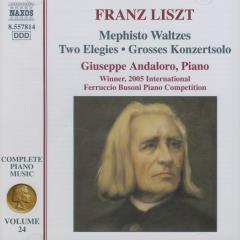Where most labels entrust their series with the complete works of this or that one to a single interpreter, Naxos uses the principle of having such series put together by different performers. In part 24 of the 'Complete piano music' by Franz Liszt (1811-1886), the Italian Giuseppe Andaloro is allowed to make his appearance. He plays the four Mephisto waltzes and the two Elegies. All of these works
… have been recorded before and due to their experimental harmonies enjoy a certain cult status, with the exception of the first Mephisto waltz, which has been a beloved showpiece of piano virtuosos since time immemorial. More interesting about this movement is the recording of 'Grosses Konzertsolo', a hefty piece, which is in fact a kind of smaller counterpart to the well-known Sonata in b. Liszt has rarely heard the piece performed. He dedicated it to the well-known virtuoso Adolph Henselt, who said by return post: 'Nobody can play that'. When Liszt later sent the work to Clara Schumann with a polite recommendation, he received a similar response, in which Clara, hinting at the weakness of the female sex, apologized for not being able to include this music in her repertoire. Fortunately for Andaloro there are no such problems and his skilful and careful reading of this rarely heard concert piece is an asset to the Liszt discography. (JvG) in which Clara, with a hint of the weakness of the female sex, apologized for not being able to include this music in her repertoire. Fortunately for Andaloro there are no such problems and his skilful and careful reading of this rarely heard concert piece is an asset to the Liszt discography. (JvG) in which Clara, with a hint of the weakness of the female sex, apologized for not being able to include this music in her repertoire. Fortunately for Andaloro there are no such problems and his skilful and careful reading of this rarely heard concert piece is an asset to the Liszt discography. (JvG)more







